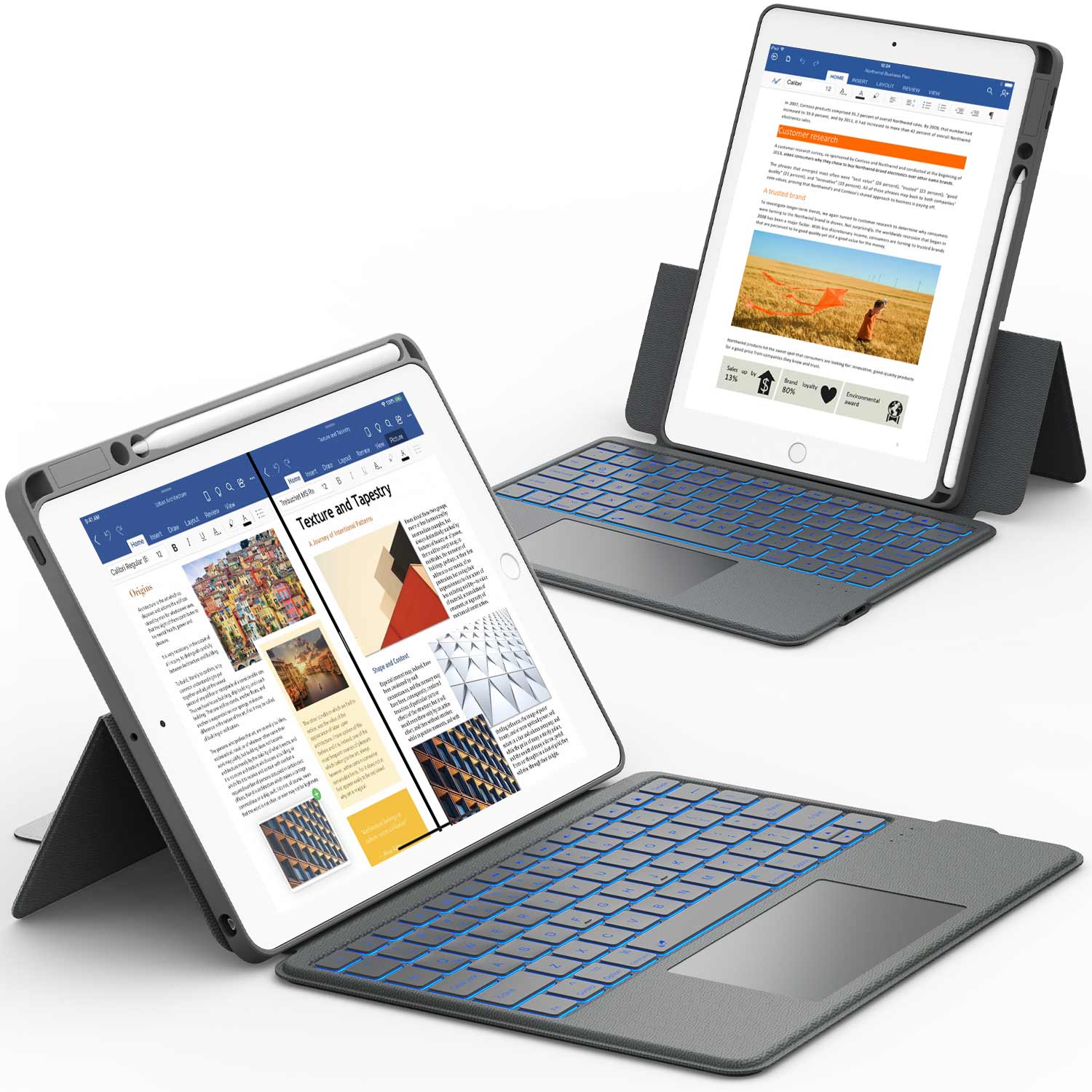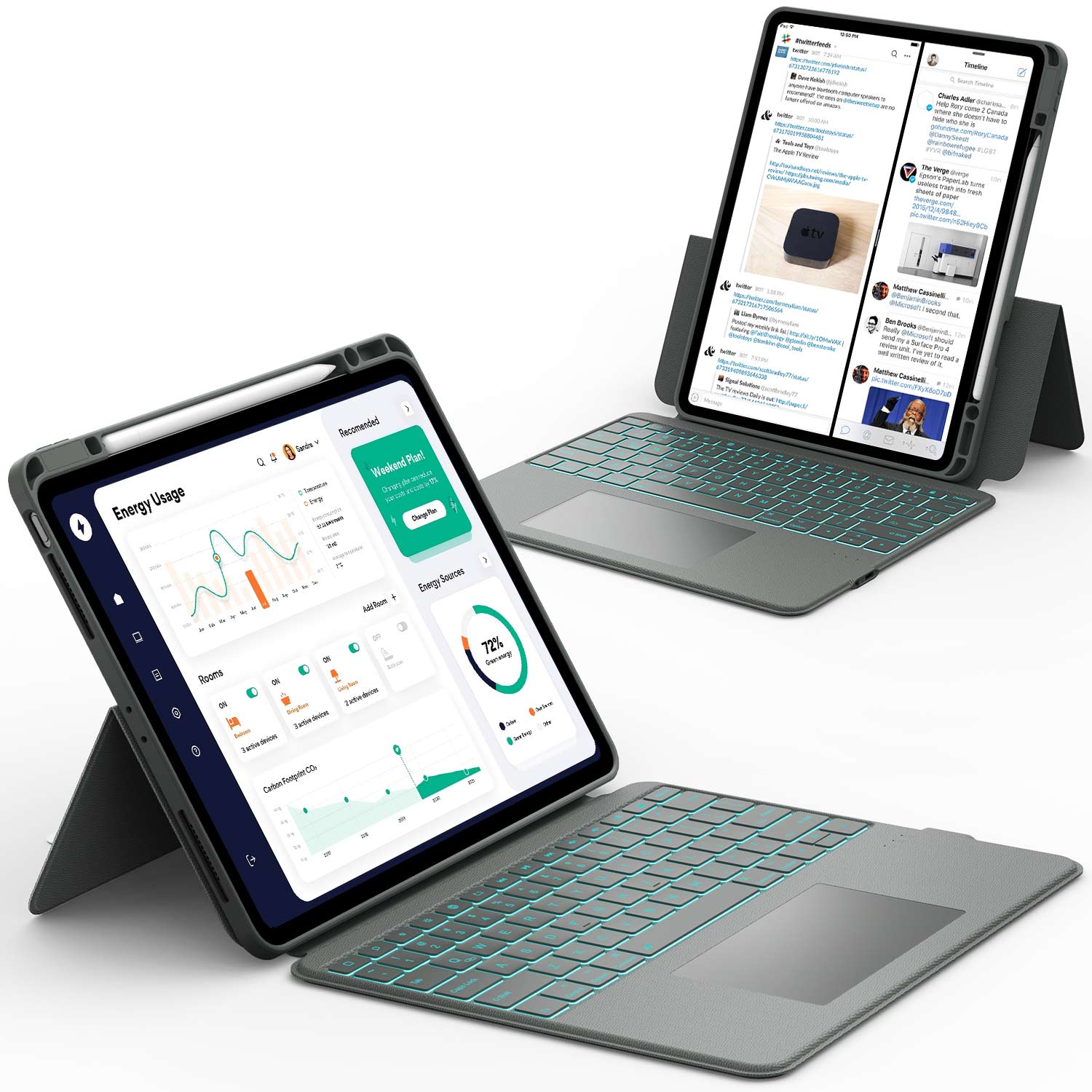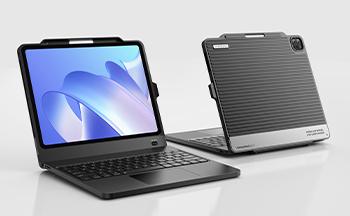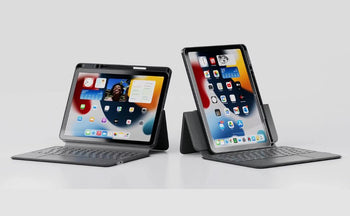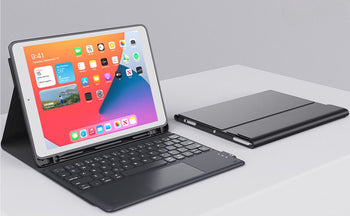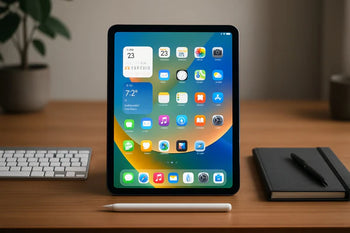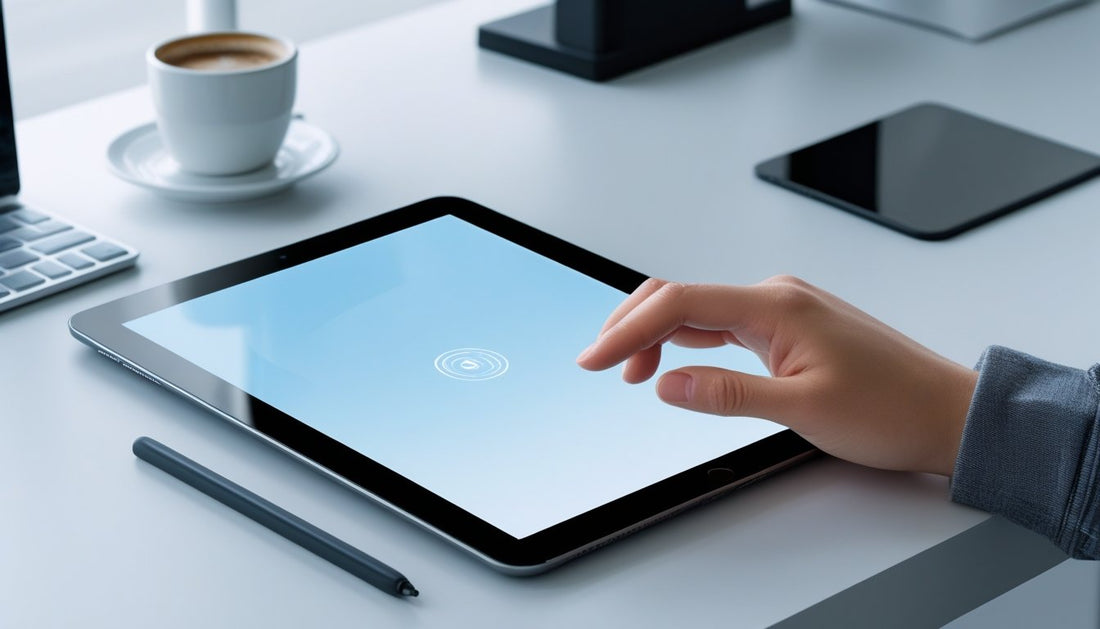If your iPad screen is not responding to touch, you’re not alone—this is one of the most common issues iPad users face. Whether your screen freezes, lags, or stops reacting altogether, the cause can range from a simple software glitch to a hardware fault.
The good news? Most of the time, you can fix it yourself with a few quick steps. In this guide, we’ll walk through the most common reasons your iPad screen stops responding and the best ways to get it working again—fast, safely, and without a trip to the repair shop.
Protect your iPad from drops and pressure that can cause screen issues. Shop our iPad Hard Cases for durable, everyday protection.
Why Your iPad Screen Is Not Responding to Touch

When your iPad touchscreen just won’t work, it usually comes down to a handful of reasons. Sometimes it’s a software hiccup, sometimes it’s dirt or moisture, sometimes it’s a screen protector or case, and once in a while, it’s actual hardware trouble.
Software Glitches or Frozen Apps
Apps crash. The system gets bogged down. Suddenly, your iPad’s screen doesn’t react. Maybe it’s just one app, maybe the whole thing is frozen. A force restart will often snap things back to life. On most iPads, press and quickly release Volume Up, then Volume Down, and hold the Top button until you see the Apple logo.
If it keeps happening, check for iPadOS updates under Settings > General > Software Update. Updates squash bugs that might mess with touch. You can also delete or reinstall any apps that keep freezing or dragging things down.
If your iPad only acts up in certain apps, it’s almost always a software thing—not a hardware failure.
Dirty or Wet Screen Surface
Even a little grime or moisture can mess with the iPad’s touch sensors. Oils, dust, or water get in the way and you end up with missed touches or laggy response. Wipe the screen with a soft, lint-free microfiber cloth. If you need to, dampen the cloth slightly with water or a bit of 70% isopropyl alcohol, but don’t spray anything directly on the screen.
If your hands are wet or you’re wearing gloves, the iPad might ignore you. Dry your hands and the screen, then try again.
Screen Protector or Case Interference
Some screen protectors—especially thick or cheap ones—can block touch input. Same goes for tight cases that squeeze the frame. Take off both the case and protector, then see if your iPad works better. If it does, swap them out for Apple-approved or well-reviewed third-party accessories.
Look for screen protectors marked ultra-thin or touch-sensitive to keep the screen responsive but still protected.
Hardware or Digitizer Issues
If a restart and a good cleaning don’t help, you might have a hardware problem. The digitizer—the bit under the glass that reads your touch—can get damaged from drops, hard knocks, or heat. Sometimes only part of the screen stops working.
Try plugging your iPad in to charge and see if anything changes. Bad cables or weird power surges can sometimes mess with touch, oddly enough.
If nothing works, it’s time to talk to Apple Support or visit a repair center. They can check for hardware faults and swap out parts if needed.
Work and type comfortably while keeping your iPad safe. Explore our iPad Case and Bluetooth Keyboard for smooth productivity anywhere.
Quick Fixes for an Unresponsive iPad Screen

If your iPad stops reacting to touch, it’s usually dirt, a glitchy app, or a little software hiccup. Cleaning, restarting, updating, or checking on your apps often gets things working again—no need to panic.
Clean the Screen and Remove Accessories
Oil, dust, and moisture—these are the usual suspects. They can throw off the touch sensors and make the screen feel frozen. Use a soft, lint-free microfiber cloth (skip the paper towels or harsh cleaners). Take off any case or screen protector and test the screen again. If it works, grab a replacement made for your iPad model.
If you’re wearing gloves or your hands are damp, dry up before you try again. The iPad needs direct skin contact to register your touch.
Force Restart Your iPad
A force restart can clear up temporary glitches. It won’t erase anything. For iPads with Face ID:
- Quickly press and release Volume Up.
- Quickly press and release Volume Down.
- Hold the Top (Power) button until the Apple logo pops up.
For iPads with a Home button:
- Hold the Home and Top (Power) buttons together.
- Let go when you see the Apple logo.
If the battery’s low, plug it in first. A force restart reloads iPadOS and usually sorts out touch issues from random crashes or stuck apps.
Update or Restore iPadOS
Old or buggy software can freeze the touchscreen. Head to Settings > General > Software Update and install anything new. Updates often fix touch problems and annoying bugs.
If nothing changes, connect your iPad to a computer with iTunes or Finder and try iOS System Recovery or the restore tools. Start with Standard Mode so you don’t lose your stuff—only do a full restore if you have to. Always back up your data before you mess with restores, just in case.
Check for App or System Freezes
If only one app seems to freeze your screen, swipe up from the bottom and flick it away in multitasking view. Then reopen it. Still stuck? Tap and hold the app icon, delete it, and reinstall from the App Store. That usually clears out any corrupted data.
When the whole system locks up, connect to a computer and use something like iOS System Recovery to repair things. These tools can fix touch response without erasing your content.
When Touch Still Doesn’t Work
If your iPad screen still ignores you after a restart and a good cleaning, you might need to try recovery tools or call in the pros. In the meantime, you can connect a keyboard or mouse to keep using your iPad while you troubleshoot or wait on repairs.
Try Recovery Mode or Factory Reset
If your iPad’s touch screen just won’t wake up, recovery mode might help fix stubborn software blocks. Plug your iPad into a computer with Finder (on newer Macs) or iTunes (on Windows or older Macs).
- Hold the right button combo for your iPad until you see the recovery screen.
- Try Update first to reinstall iPadOS without erasing your stuff.
- If that doesn’t work, pick Restore—but this wipes everything.
Back up your data before a factory reset. If your iPad won’t show up in recovery mode, try a different cable or USB port. If nothing helps, it’s probably a hardware issue that needs a pro.
Use an External Keyboard or Mouse Temporarily
If the screen’s dead but the iPad powers on, you can still get around using a Bluetooth keyboard or mouse. Go to Settings > Accessibility > Touch > AssistiveTouch to pair them, or use a USB-C or Lightning adapter for wired devices.
This way, you can back up files, check settings, or prep for a repair—even if you can’t use the touchscreen. Voice Control or Siri can also help with basic actions. Some older iPads might not support every accessory, so results can vary.
Contact Apple Support or a Repair Technician
If none of these fixes bring your touchscreen back, it’s time to reach out to Apple Support. Head to the Apple Support website or use their app to line up a repair.
Apple can run diagnostics remotely to spot hardware problems like a busted digitizer or touch IC chip. If you’ve got warranty or AppleCare+, repairs might even be free.
Stick with authorized service providers or Apple Stores—they use real parts and tools. Third-party repairs can void your warranty or just make things worse. Always back up your iPad before sending it in.
How to Prevent Future Touch Screen Problems
Keeping your iPad’s touchscreen reliable isn’t rocket science. Regular updates, solid accessories, and a bit of care go a long way. A good case, proper charging gear, and up-to-date software all help avoid unresponsive screens and hardware headaches.
Keep iPadOS Updated
Apple rolls out iPadOS updates to fix bugs and keep things running smoothly. Skip enough updates, and little glitches can pile up until your iPad just doesn’t play nice anymore.
Check for updates under Settings > General > Software Update. If there’s something new, connect to Wi‑Fi and tap Download and Install.
You can also update through a computer using Finder or iTunes. Always back up your data first—better safe than sorry.
Use Certified Accessories Only
Cheap, uncertified chargers or cables can mess with your touchscreen. Bad accessories sometimes cause weird power issues or interference that make the screen go haywire.
Look for MFi-certified (Made for iPhone/iPad) labels when shopping for third-party gear. If your screen gets weird while charging, unplug and see if that’s the culprit. Swap out anything that causes trouble.
|
Accessory Type |
Recommended Option |
Avoid |
|
Charging Cable |
Apple or MFi-certified cable |
Cheap third-party cables |
|
Power Adapter |
Apple-branded or certified adapter |
Unlabeled or damaged chargers |
|
Stylus |
Apple Pencil or supported model |
Generic styluses with no certification |
Sticking with certified accessories helps your iPad’s hardware last and keeps the touch screen working like it should.
Protect Your iPad with a Quality Case
A solid case keeps your iPad safe from drops, dust, and those weird temperature swings that sometimes mess with the display. Look for a case with raised edges—that tiny lip around the front really helps if you ever drop it face-down.
Steer clear of cases that squeeze too tightly around the edges or sensors. They can trigger false touches, which is just annoying.
Wipe down your case and screen now and then with a soft, lint-free cloth. Bits of dirt or grit trapped between the case and the screen can mess with touch over time—nobody wants that.
If you use a screen protector, pick one that's thin, fits your iPad model perfectly, and doesn't leave bubbles. The wrong size or a sloppy install can kill touch sensitivity or leave dead spots. Why risk it?
Add premium style and reliable protection with a Leather iPad Case. Sleek, durable, and perfect for daily use.
Conclusion: iPad Screen Not Responding To Touch
If your iPad screen isn’t responding to touch, don’t panic. In most cases, a quick restart, cleaning the screen, or updating iPadOS will get things back to normal. If the issue continues, it might be time to check for hardware damage or reach out to Apple Support.
Keeping your software updated and using quality accessories can help prevent future touch issues. A little maintenance goes a long way in keeping your device running smoothly.
Having trouble with other iPad functions? Read our guide on why you can’t delete apps on your iPad.
Frequently Asked Questions: iPad Screen Not Responding To Touch
Sometimes, an unresponsive iPad just needs a quick screen cleaning, accessory removal, or a simple restart. If that doesn't do the trick, try a force restart or update the software. You might get touch back without needing to visit a repair shop.
How do I fix an unresponsive iPad touch screen?
Wipe the screen with a soft, slightly damp cloth and remove any case or screen protector. Unplug accessories like chargers or keyboards that could interfere. If it’s still unresponsive, restart your iPad or check for software updates.
What to do when your iPad is frozen and you can't touch anything?
Try a force restart first—it usually clears temporary freezes. If that doesn’t work, connect your iPad to a computer with iTunes or Finder. You may need to use recovery mode to restore it.
How to force shut down iPad when touch screen not working?
Hold the Top button and a Volume button until the screen goes black. Keep holding until the Apple logo disappears. This forces a shutdown even if the screen won’t respond.
How to do a force restart on iPad?
For Face ID models, press and release Volume Up, then Volume Down, then hold the Top button until the Apple logo appears. For Home button models, hold the Home and Top (or Side) buttons together until you see the logo. This just restarts your iPad—it won’t erase anything.

